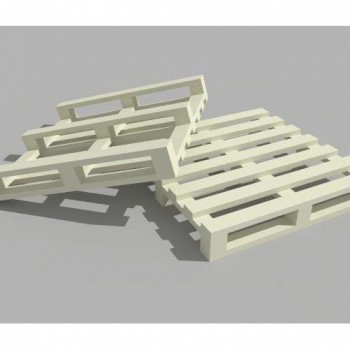3D pallet printing
31 Mar 2014

3D printing is still in it infancy, but it heralds a great new future for plastics engineering. Anyone will be able to buy a 3D printer for the price of a laptop and make any kind of product, such as engine parts, tableware, tools, clothing and even a plastic pallet
All of this means that assuming the printer has a secure supply of plastic filament to mould the printed articles, goods will be made anywhere at any time — nationally, internationally or locally.
Recycling
Such an expansion in the use of plastics does not mean that there will be an environmental disaster as many plastics are recyclable into fully suitable printing materials.
Pallets and Models
It is easy to make a 3D-printed pallet out of plastic. The standard European pallet, known as the EUR pallet, comes in a 1200 mm x 800 mm size in a variety of polymers suitable for light, medium and heavy duties. 3D printers are able to produce these pallets at their full size or in a scaled-down model for decorative purposes.
Printing Process
So far, 3D printing has only produced model pallets made from a wood-fibre-based filament. The final product looks like a wooden pallet. It uses a material extrusion technology, where the filament output from the nozzle of the printer moves along X and Y axes tracing out the outline of the pallet on a build platform surface. As the platform lowers, the process is repeated until the object is complete.
Thermoplastics
Thermoplastics are the most common materials used in 3D printing. These are mostly acrylonitrile butadiene styrene (ABS), ABSi, a translucent and stronger version of ABS, polyactic acid (PLA0 and polycarbonates. ABS is the favourite material for filament and is used widely in the vehicle manufacturing sector.
HDPE Difficulties
However, plastic pallets are made often from high-density polyethylene, a thermoplastic with great strength and an ability to resist aggressive liquids, making it useful for piping, fuel tanks, bottles and a .variety of sports equipment
Used and waste HDPE is widely available but is not popular for use as a 3D printing material. The material does bind to itself very easily so, in theory, a HDPE article can be built up slowly but it does not bind easily to other materials.
The build platform on the printer should be made of HDPE if this thermoplastic is going to be used as a filament.
Warps on Cooling
Another problem is that HDPE can warp on cooling because of the thermal stresses involved. Plastic pallet manufacture has to be carried out according to strict specifications about strength and durability.
So a home-made 3D-printed pallet may not yet be strong enough to substitute for the conventionally manufactured article. Anyone using a 3D printer for the first time should become expert in making articles from ABS or PLA before trying to recycle any HDPE into pallets.
